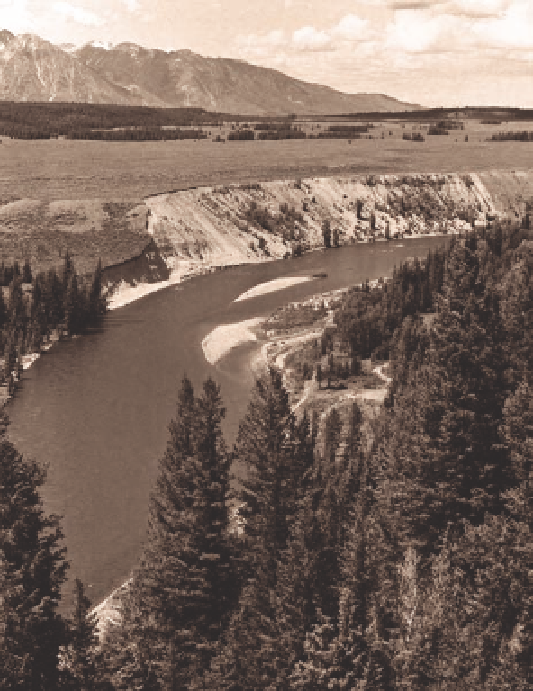Geoscience Reference
In-Depth Information
solved from calcareous rocks and deposited on the for-
mer floodplain. now, with periodic wetting, the salts are
slowly moved upward when the soils are wet and then
deposited on the surface as the water evaporates. conse-
quently, halophytes (salt-tolerant plants) are sometimes
found on terraces. Less salt-tolerant species occur on the
adjacent floodplain, where floodwaters periodically dis-
solve the salts and transport them downstream.
the most successful cottonwood regeneration occurs
along sand and gravel bars after major floods that de-
posit floating seeds high on the bank, where the seed-
lings that develop are not likely to be washed away by
the surface to provide the water needed by the saplings,
a curvilinear band of trees develops that provides a liv-
ing record of flooding patterns and channel migration
(figs. 4.7-4.9). As the channel moves across the flood-
Fig. 4.7. Band of plains cottonwood seedlings along the Big-
horn River east of Lovell. Most of the seedlings die, but a few
survive if they are high enough on the bank to avoid being
washed away by subsequent floods and if groundwater remains
accessible. A curvilinear band of trees often develops, such as
those apparent in fig. 4.9. See cooper et al. (1999) and Scott
et al. (1997) for estimates of flood size required for successful
cottonwood seedling establishment. elevation 3,700 feet.
Fig. 4.6. the Snake River in Grand teton national Park, with
young trees and shrubs on point bars (on the right) and a cut
bank (on the left) with some trees about to fall into the river.
Douglas-fir is the dominant tree on the escarpment in the
foreground, and mountain big sagebrush steppe occurs on
the terrace—a former glacial outwash plain—just beyond the
river. Lodgepole pine forests occur on glacial moraines in the
background. See fig. 15.3 for a photograph taken approxi-
mately 90° to the left. elevation 6,700 feet.
now, with the glaciers gone and with different climatic
conditions, the rivers are smaller. they also have less
of a sediment load and, consequently, are more likely
to incise streambeds. Along some rivers there are two
or three pronounced terraces, each the result of a dif-
ferent period of glaciation and downcutting (see fig.
15.3).
Such substrate characteristics as texture, salinity, and
depth to water table are not uniform, causing patchi-
ness in the vegetation. in Jackson Hole, for example,
mid-channel bars of sand and gravel are often occupied
by sandbar willow, fine-textured soils on the floodplain
have Booth's willow, and the terraces regularly have
likely to become saline because of salts that were dis-


Search WWH ::

Custom Search